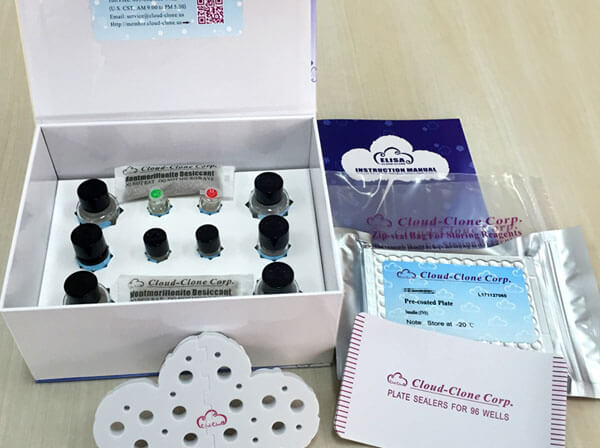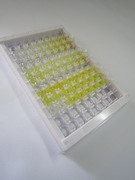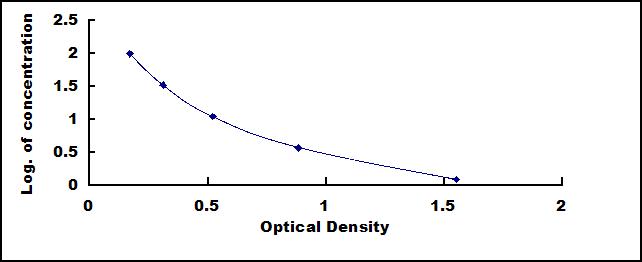ELISA Kit for Glutathione (GSH) 

L-Reduced Glutathione
- UOM
- FOB US$ 557.00 US$ 796.00 US$ 3,580.00 US$ 6,763.00 US$ 55,692.00
- Quantity
Overview
Properties
- Product No.CEA294Ge
- Organism SpeciesPan-species (General) Same name, Different species.
- ApplicationsEnzyme-linked immunosorbent assay for Antigen Detection.
Research use only - DownloadInstruction Manual
- CategoryMetabolic pathway
Sign into your account
Share a new citation as an author
Upload your experimental result
Review

Contact us
Please fill in the blank.
Recovery
Matrices listed below were spiked with certain level of Glutathione (GSH) and the recovery rates were calculated by comparing the measured value to the expected amount of Glutathione (GSH) in samples.
| Matrix | Recovery range (%) | Average(%) |
| serum(n=5) | 83-105 | 87 |
| EDTA plasma(n=5) | 86-93 | 89 |
| heparin plasma(n=5) | 88-104 | 97 |
Precision
Intra-assay Precision (Precision within an assay): 3 samples with low, middle and high level Glutathione (GSH) were tested 20 times on one plate, respectively.
Inter-assay Precision (Precision between assays): 3 samples with low, middle and high level Glutathione (GSH) were tested on 3 different plates, 8 replicates in each plate.
CV(%) = SD/meanX100
Intra-Assay: CV<10%
Inter-Assay: CV<12%
Linearity
The linearity of the kit was assayed by testing samples spiked with appropriate concentration of Glutathione (GSH) and their serial dilutions. The results were demonstrated by the percentage of calculated concentration to the expected.
| Sample | 1:2 | 1:4 | 1:8 | 1:16 |
| serum(n=5) | 94-103% | 90-102% | 79-104% | 97-105% |
| EDTA plasma(n=5) | 94-103% | 94-102% | 97-104% | 82-92% |
| heparin plasma(n=5) | 94-101% | 78-101% | 90-97% | 81-96% |
Stability
The stability of kit is determined by the loss rate of activity. The loss rate of this kit is less than 5% within the expiration date under appropriate storage condition.
To minimize extra influence on the performance, operation procedures and lab conditions, especially room temperature, air humidity, incubator temperature should be strictly controlled. It is also strongly suggested that the whole assay is performed by the same operator from the beginning to the end.
Reagents and materials provided
| Reagents | Quantity | Reagents | Quantity |
| Pre-coated, ready to use 96-well strip plate | 1 | Plate sealer for 96 wells | 4 |
| Standard | 2 | Standard Diluent | 1×20mL |
| Detection Reagent A | 1×120µL | Assay Diluent A | 1×12mL |
| Detection Reagent B | 1×120µL | Assay Diluent B | 1×12mL |
| TMB Substrate | 1×9mL | Stop Solution | 1×6mL |
| Wash Buffer (30 × concentrate) | 1×20mL | Instruction manual | 1 |
Assay procedure summary
1. Prepare all reagents, samples and standards;
2. Add 50µL standard or sample to each well.
And then add 50µL prepared Detection Reagent A immediately.
Shake and mix. Incubate 1 hour at 37°C;
3. Aspirate and wash 3 times;
4. Add 100µL prepared Detection Reagent B. Incubate 30 minutes at 37°C;
5. Aspirate and wash 5 times;
6. Add 90µL Substrate Solution. Incubate 10-20 minutes at 37°C;
7. Add 50µL Stop Solution. Read at 450 nm immediately.

Test principle
This assay employs the competitive inhibition enzyme immunoassay technique. An antibody specific to glutathione has been pre-coated onto a microplate. A competitive inhibition reaction is launched between biotin labeled glutathione and unlabeled glutathione (Standards or samples) with the pre-coated antibody specific to glutathione. After incubation the unbound conjugate is washed off. Next, avidin conjugated to Horseradish Peroxidase (HRP) is added to each microplate well and incubated. The amount of bound HRP conjugate is reverse proportional to the concentration of glutathione in the sample. After addition of the substrate solution, the intensity of color developed is reverse proportional to the concentration of glutathione in the sample.
Giveaways
Increment services
Citations
- Evidence for augmented oxidative stress in the subjects with type 1 diabetes and their siblings: a possible preventive role for antioxidantsPubMed: 22781023
- Glutathione S-Transferase P1 Correlated with Oxidative Stress in Hepatocellular CarcinomaPubMed: PMC3619117
- Alteration in the intrafollicular thiol–redox system in infertile women with endometriosisPubmed:25376627
- Effects of mild hypothermia therapy on the levels of glutathione in rabbit blood and cerebrospinal fluid after cardiopulmonary resuscitationPubMed: 25810895
- Oxidative Stability of Ostrich Meat Related to Duration of Linseed and Lucerne Supplementation to the Bird's DietView: J
- Prenatal maternal distress affects atopic dermatitis in offspring mediated by oxidative stressPubmed:27016803
- Hydrogen sulfide protects against chronic unpredictable mild stress-induced oxidative stress in hippocampus by upreCavia (Guinea pig )lation of BDNF-TrkB pathwayjournals:2153745.pdf
- Rapid opioid detoxification with an implementation of the new method of gradually increasing dosage of naltrexone inductionobject:elaba:15733325
- Toxicity study of oxalicumone A, derived from a marine-derived fungus Penicillium oxalicum, in cultured renal epithelial cellspubmed:28260084
- Hepatocellular toxicity of oxalicumone A via oxidative stress injury and mitochondrial dysfunction in healthy human liver cellspubmed:29115483
- Metabolomic and transcriptomic profiling of hepatocellular carcinomas in Hras12V transgenic micepubmed:28941178
- Circulating cell-free DNA of methylated insulin-like growth factor-binding protein 7 predicts a poor prognosis in hepatitis B virus-associated hepatocellular carcinoma …Pubmed:29463155
- Epigallocatechin-3-Gallate Reduces Neuronal Apoptosis in Rats after Middle Cerebral Artery Occlusion Injury via PI3K/AKT/eNOS Signaling PathwayPubmed:29770336
- Epigallocatechingallate attenuates myocardial injury in a mouse model of heart failure through TGF‑β1/Smad3 signaling pathwayPubmed:29620209
- Effects of ginsenoside Rb1 on oxidative stress injury in rat spinal cords by regulating the eNOS/Nrf2/HO‑1 signaling pathwayPubmed:30116359
- Effects of Tualang honey in modulating nociceptive responses at the spinal cord in offspring of prenatally stressed ratsDoi: 10.1016/j.joim.2018.12.002
- Protective effects of sulforaphane on diabetic retinopathy: activation of the Nrf2 pathway and inhibition of NLRP3 inflammasome formationPubmed: 30606939
- Porous Se@ SiO2 nanosphere-coated catheter accelerates prostatic urethra wound healing by modulating macrophage polarization through reactive oxygen species …Pubmed: 30753941
- MicroRNA‑21 contributes to the puerarin‑induced cardioprotection via suppression of apoptosis and oxidative stress in a cell model of ischemia/reperfusion injuryPubmed: 31115556
- Germinated-soy milk as a healthy diet to induce high antioxidant enzymes in breast milk
- Hydrogen Sulfide Prevents Sleep Deprivation-Induced Hippocampal Damage by Upregulation of Sirt1 in the HippocampusPubmed: 32218719
- Dexmedetomidine Attenuates Orthotopic Liver Transplantation-Induced Acute Gut Injury via α2-Adrenergic Receptor-Dependent Suppression of Oxidative StressPubmed: 31827710
- Exosomes of Antler Mesenchymal Stem Cells Improve Postoperative Cognitive Dysfunction in Cardiopulmonary Bypass Rats through Inhibiting the TLR2 …Pubmed: 32300366
- Antiepileptic effects of exogenous β‑hydroxybutyrate on kainic acid‑induced epilepsyPubmed: 33101467
- Association Between Serum Selenium Level and Subclinical Mastitis in Dairy CattlePubmed: 32583225
- Formaldehyde induces ferroptosis in hippocampal neuronal cells by upregulation of the Warburg effect33259821
- Glutamine deficiency promotes stemness and chemoresistance in tumor cells through DRP1-induced mitochondrial fragmentation33895866
- Naringenin alleviates myocardial ischemia reperfusion injury by enhancing the myocardial miR-126-PI3K/AKT axis in streptozotocin-induced diabetic rats34093766
- MicroRNA-145-5p aggravates cell apoptosis and oxidative stress in tongue squamous cell carcinoma33732346
- Oxidative stress-and mitochondrial dysfunction-mediated cytotoxicity by silica nanoparticle in lung epithelial cells from metabolomic perspective33662726
- Lycium barbarum polysaccharides attenuate cardiovascular oxidative stress injury by enhancing the Keap1/Nrf2 signaling pathway in exhaustive exercise rats34278476
- κ-Opioid Receptor Agonist Ameliorates Postoperative Neurocognitive Disorder by Activating the Ca2+/CaMKII/CREB Pathway34608407
- Alamandine alleviates hypertension and renal damage via oxidative-stress attenuation in Dahl ratsPubmed:35022384
- Intake of Bifidobacterium lactis Probio-M8 fermented milk protects against alcoholic liver diseasePubmed:35086715
- Antioxidant Effect of Tyr-Ala Extracted from Zein on INS-1 Cells and Type 2 Diabetes High-Fat-Diet-Induced MicePubmed:35740008
- The κ-Opioid Receptor Agonist U50488H Ameliorates Neuropathic Pain Through the Ca2+/CaMKII/CREB Pathway in RatsPubmed:35645576











